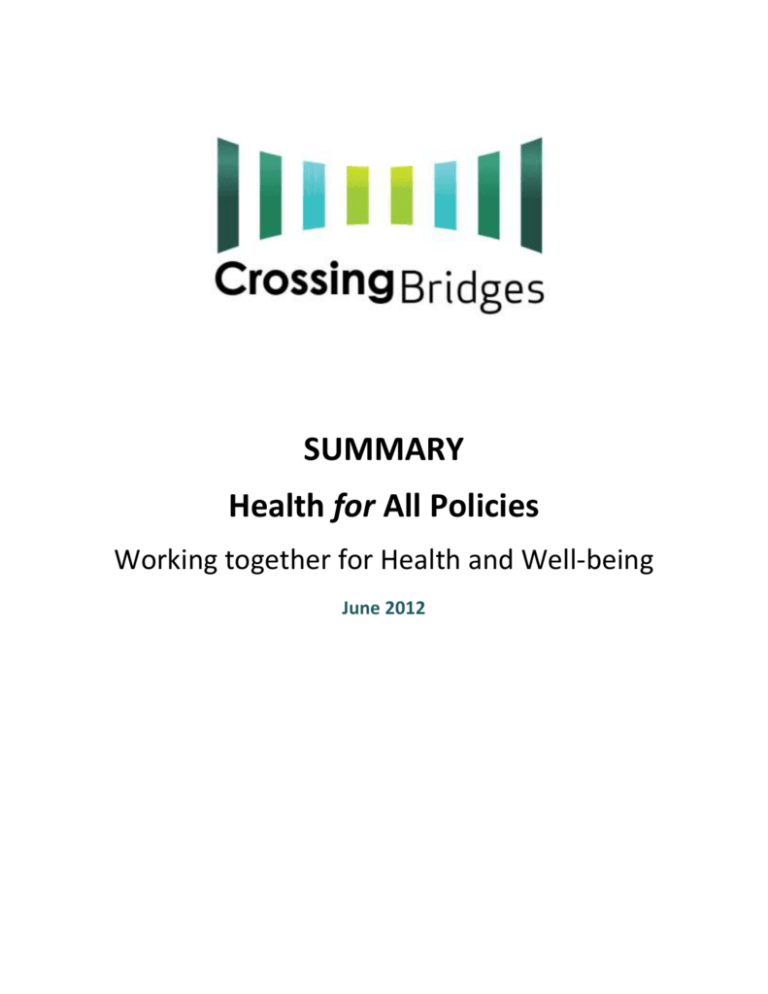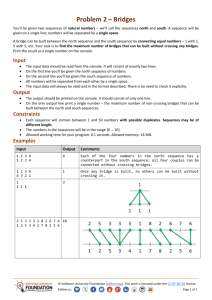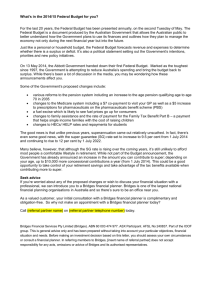88_Summary Final Crossing Bridges Publication
advertisement

SUMMARY Health for All Policies Working together for Health and Well-being June 2012 Authors This summary of the final report of Crossing Bridges (2011-2012) was written by Ingrid Stegeman, Yoline Kuipers and Caroline Costongs from EuroHealthNet, on behalf and with the input of the Crossing Bridges project partners. We would like to thank all those who contributed examples and their experiences to the Crossing Bridges Focus Area Group work and to the development of the Capacity Building Trainings, who are listed in the relevant publications reflecting the outcomes of this work. All Crossing Bridges publications are available on www.health-inequalities.eu. Crossing Bridges This publication presents outcomes of the Crossing Bridges project (Jan 2011 –June 2012). Crossing Bridges is an EU co-funded initiative that aims to address the question of how the health sector could work more closely with other sectors to ensure that their policies and actions contribute to improved health and well-being. The initiative brought together 16 organisations from 13 EU countries. Crossing Bridges partners identified examples of collaboration between the health and other sectors (Education, Urban Planning and Transport, Agriculture) and analysed these to draw learning about effective processes of crosssectoral collaboration for health. In addition, a framework for a capacity building training workshop “Achieving a Win-Win for Health and Health Equity” was developed and delivered to trainers in participating countries, who adapted the module to their national settings and delivered it to public health professionals in their countries. Further information on Crossing Bridges and its outcomes are available on www.health-inequalities.eu EuroHealthNet EuroHealthNet coordinated the work of the Crossing Bridges project. EuroHealthNet is a not for profit network of organisations, agencies and statutory bodies working to promote health and equity by addressing the factors that determine health directly or indirectly. EuroHealthNet offers advice and information for policy makers, promotes good practices and innovations, and seeks to practice ethical and sustainable methods to achieve the aims and objectives set by its members and partners. For further information please visit www.eurohealthnet.eu. Project Partners The following organisations were involved in the Crossing Bridges project: Austria - Gesundheit Österreich GmbH (GÖG) Belgium - Flemish Institute for Health Promotion and Disease Prevention (VIGeZ) Czech Republic - National Institute of Public Health (SZU) England - NHS Sefton Germany - Federal Centre for Health Education (BZgA) Greece - Institute of Preventive Medicine, Environmental & Occupational Health (PROLEPSIS) Hungary - National Institute for Health Development (OEFI) Ireland - Institute of Public Health in Ireland (IPH) Italy - Verona University Hospital (Azienda Ospedaliera Universitaria Integrata Verona) Netherlands - Netherlands Institute for Health Promotion (NIGZ) Netherlands – National Institute for Public Health and the Environment (RIVM) Poland - National Institute of Public Health - National Institute of Hygiene (NIPH-NIH) Slovenia - National Institute of Public Health (NIPH-IVZ) Wales - Public Health Wales (PHW) International Union for Health Promotion and Education (IUHPE) This publication arises from the Crossing Bridges project (2009 12 23), which has received funding from the European Commission, in the Framework of the Health Programme Rationale Health promotion and disease prevention to reduce the incidence and prevalence of people suffering from illness and disease is key to sustaining health systems and improving quality of life in the EU. Effective health promotion and disease prevention cannot be achieved simply through clever campaigns to encourage people to adopt healthier behaviours and lifestyles. It is, for example, difficult to respond to messages to eat more fresh fruits and vegetables and to exercise when heavily processed foods are, in many areas, less expensive and easier to obtain, or when urban environments are crowded, unsafe and polluted. Public health actors must therefore work more closely with other sectors to improve the conditions outside of the health sector that shape health. This means raising awareness and holding other sectors accountable for their impacts on health. But it is not simply an issue of responsibility – everyone benefits from good health, as it improves workforce productivity, increases capacity to learn, strengthens families and communities, supports sustainable habitats and environments and contributes to security, poverty reduction and social security.1 In the words of Martin Seychell, Deputy Director of the EU Directorate General Health and Consumer Affairs: “All countries should have a growth agenda in which health has a central role.”2 The idea of working together for health and well-being is not new. It is one that has been around since the 1970’s, in the form of the concepts of ‘inter-sectoral-action for health’, ‘Healthy Public Policy’, and Health in All Policies. Recently, the work of the WHO Commission on the Social Determinants of Health (CSDH) has given these concepts a strong impetus. While these concepts of working together for health are not new, they are still not being translated into action in a systematic way. This is because while there is broad consensus around this approach, there is still uncertainty within the public-health and related professions on how to achieve this. Working Together for Health and Well-being – How? The learning drawn from Crossing Bridges reflects that there is no single approach to doing this. It is a process with many different, inter-related entry points and approaches, and one that takes time, commitment and persistence. Public health actors can apply a wide range of strategies, tools and mechanisms to achieve this. They can for example aim to engage other sectors in achieving health-related goals (e.g. tobacco reduction), or cooperate with other sectors to help them achieve their goals in ways that are also good for health.3 To achieve this, they can organize or take part in cross-sectoral committees or cross-sectoral action 1 Adelaide Statement on Health in All Policies. Geneva, World Health Organization, 2010 (www.who.int/ social_determinants/en/, accessed 6 June 2012) 2 Martin Seychell at Crossing Bridges Final Conference “Working Together for Health and Well Being”. Brussels, May 29, 2012 3 Ollila, E. Health in All Policies: From rhetoric to action. Scand J Public Health 2011 39:11 teams and/or apply tools like health impact assessments or health-lens analyses. They can also employ people with experience in other sectors with insight on how to engage them in working for health. Crossing Bridges outcomes have confirmed that developing a systematic approach to engaging others for health is facilitated by strong leadership at government and organizational level in terms of relevant mandates and regulations. It also depends on well informed, committed people that champion the approach and on professionals with good persuasive communication and negotiation skills as well as strong management skills, who can steer cross-sectoral processes and build trust and competencies amongst the actors involved. In addition it requires good organizational structures, resources and time to make this happen. All of this depends on a strong evidence base, which must be employed to raise awareness of how other sectors’ impact on health and to hold them accountable. Policy makers, civil servants and public health professionals must be encouraged and trained to identify those opportunities that best suit their specific contexts, priorities and competences, to engage with other sectors, and to exploit these opportunities. This means developing strategies and action plans and implementing through the most suitable tools to engage others in optimizing public health outcomes. Figure 1: Four interrelated key elements that need to be in place to facilitate and ensure successful cross-sectoral collaborations Action Points and Challenges to Overcome Progress on a more systematic implementation of ‘Health for All Policies’ (HfAP) faces the following action points and challenges that must be addressed and overcome in order to generate more systematic efforts of collaborative working. Language: The language of engagement is very important to success. While the term ‘Health in All Policies’ is commonly used to describe the process of ensuring that other policy areas consider health outcomes, it can be off-putting since it implies an ‘imperialist’ attitude and approach, in which healthconsiderations predominate over others. Rather than expecting other sectors to understand health, the health sector must improve its ability to understand the language, culture and priorities of other sectors and to see from their perspective ‘what is in it for them’. Health ‘for’ all policies more appropriately reflects the approach that should be taken to achieve the desired objective. In many cases it may also be better to avoid the term ‘health’ altogether and to refer well-being or quality of life. Attribution and Accountability: Evidence of a successful intervention cannot be evaluated in the short to medium term and causal relationships may not be reasonably established. This means that health professionals will sometimes need to be flexible in their role and accept that wins must be shared. The health sector may perhaps have to give headline credit to another sector. Those from the health sector that are trying to achieve HfAP objectives must therefore identify what success looks like to them. Sharing resources: Linked to the challenges of attribution and accountability, is that of obtaining and justifying health sector expenditures to advance the explicit objectives of other sectors. While acting on the social determinants of health will implicitly improve health and well-being, these correlations are not easy to establish and health related improvements complex to quantify. As a result, it is difficult to know whether the human and financial resources applied by the health sector to e.g. reduce crime levels or to contribute to the content of community development plans have any real impact on health, and are therefore justified. There is therefore a need for more and better evidence on how social determinants impact on health. This requires collaborative approaches to data collection and analysis to try and identify health outcomes from actions taken within other policy domains. Economic conditions: Crossing Bridges outcomes indicate that declining resources, both financial and human, risk reversing the gains made in developing cross-sectoral approaches. It could lead to retrenchment as budget cuts in fact mean that organisations and individuals become more possessive of their budgets and find their professional influence confined to immediate imperatives within their domains. However, the current economic crisis is considered by some as an opportunity for HfAP, since it provides an impetus to rationalise and restructure the use of resources (for more efficient, joined-up work) and encourages more cross-sectoral collaboration. Resistance to change: Another challenge to the implementation of HfAP is resistance among public health actors to move away from traditional (lifestyle focused) approaches to health promotion, since change is not easy and many actors have vested interests in existing approaches and structures. This was reflected for example in the Case Study Report on Transport and Planning, which identified that it was often health professionals themselves who appeared more reticent in engaging with other sectors and who are the obstacles to effective HfAP. Public Health education therefore needs to incorporate training to address these issues. Tension between the need for long term approaches and short term results: The outcomes of Crossing Bridges highlighted that developing approaches to meet HfAP approaches requires long term approaches to, for example, build up the knowledge and skills of the workforce, to build and maintain strong relationships with actors in other sectors and to establish the structures that are needed to facilitate HfAP. At the same time, maintaining a momentum in efforts to expand this approach and to convince politicians, policy makers and organizational leads of the need to take action requires short term evidence of its success. The exchange of knowledge and information on effective actions on social determinants that proved beneficial to health and health equity is therefore crucial. Capacity Building Training to achieve HfAP objectives: The Crossing Bridges project developed a Capacity Building Training that provides a framework for an introductory course to raise awareness amongst targeted groups of public health and health promotion professionals of approaches that they can take to achieve the concept of health for all policies. It points trainers to theoretical materials that they can use to develop the course, and provides examples of practical exercises to engage trainees in ‘experiential learning’. Being able to identify opportunities and priorities in a specific setting for engagement with other sectors and developing abilities to negotiate interests are, for example, important skills that are necessary to take forward the objectives of HfAP. While providing a theoretical overview of HfAP is important, the concept is difficult to convey without practical application. Those who participated in the training emphasized the importance of basing them on practical, interactive exercises that led to ‘learning by doing’. In addition, they highlighted the importance and need for reallife, practical examples of HfAP. Crossing Bridges’ has aimed to identify such examples. Supportive HfAP organisations Crucial to addressing the above-mentioned action-points and challenges relating to HfAP is to ensure that all organizations working on public health, health promotion and disease prevention are supportive of this approach. Crossing Bridges work has reinforced that while levels of awareness and action on ‘intersectoral action for health’ and ‘HiAP’ in the EU Member States and regions that participated in the project differ, there is in most cases some level of understanding of these concepts. Governments and the health sector in particular are not, however, displaying a readiness to act on this understanding and to change their approach. Outcomes of a survey amongst public health professionals participating in Crossing Bridges Capacity Building trainings reflect that although they note their organisations understand the importance of concepts like HiAP, many do not feel supported in their efforts to act on this. Below is a list of key elements, which emerged through discussions amongst a Crossing Bridges Expert Group, of what a “HfAP supportive” organization could look like. To begin with, HfAP has to be an acknowledged value of the organisation and recognised as a key approach to improving public health (HfAP as a strategic priority and objective). A supportive context is important not only to the efficiency and effectiveness of the staff working on HfAP, but also to that of the organisation as a whole. To ensure sustainability, it is crucial to build up (financial) structures and put mechanisms in place that allow for a long term perspective. Sustainability is crucial for HfAP to be effective. In order to ensure that an organisation’s strategic priorities and approaches are not too influenced by (changes in) government priorities and policy (sustainability), their funding bases should be varied. A possible motivation for institutes to embrace HfAP is the need to diversify partnerships to stretch finances (e.g. partnering to obtain Structural Funds). It is important that institutes are able to work effectively with small budgets; even in times of prosperity cost-effectiveness is crucial. HfAP friendly organisations should employ people with multi-sectoral skills and competences, who can engage with other sectors. These people should have a good insight into the ‘culture’ and priorities of other sectors and they should have strong negotiation, communication and management skills. This could mean engaging people that were previously employed by a different sector and thus have the knowledge and experience of the work environment and priorities of other departments, and are able to the speak the ‘language’ of the other sector. It can also entail employing people who work part-time for the health sector and part-time for another sector (joint appointments / job sharing). Finally, staff in HfAP friendly organisations could make contact with health desks or health ‘hubs’ in other departments, that report systematically back to the health sector, or they could be seconded to worik in other sectors. The HfAP approach is greatly facilitated and operationalized through the establishment of a specialised HfAP and/or Health Impact Assessment (HIA) unit or ‘task force’ with a clear responsibility to engage in cross-sectoral cooperation. The core competences and tasks of the unit and its staff should be pre-defined and clear from the start. HfAP friendly organisations and staff should take a targeted approach to HfAP. This means that rather than trying to engage with and/or build evidence in all sectors, they should analyse what sectors to engage with, based on their specific contexts, capacities and where they are likely to have the biggest potential impact on health outcomes. They should then develop action plans on the bases of these analyses, which link their priorities with those of the selected sectors, that apply the language of other sectors and that identify the win-win scenarios. An HfAP approach often means that the interests of the health sector and those of other sectors must be negotiated. This signifies that health interests may not necessarily predominate in these exchanges. Person’s engaged in HfAP may therefore need to be protected if health interests do not seem to prevail or are not clearly evident as an outcome of cross-sectoral work. People can be placed under a lot of pressure when different sectors have different priorities and conflicting interests. Organisations and their staff should nevertheless be willing to face such conditions, and to take risks. It is important to work with incentives and rewards to keep motivation high and to encourage people to persevere even under difficult circumstances.





